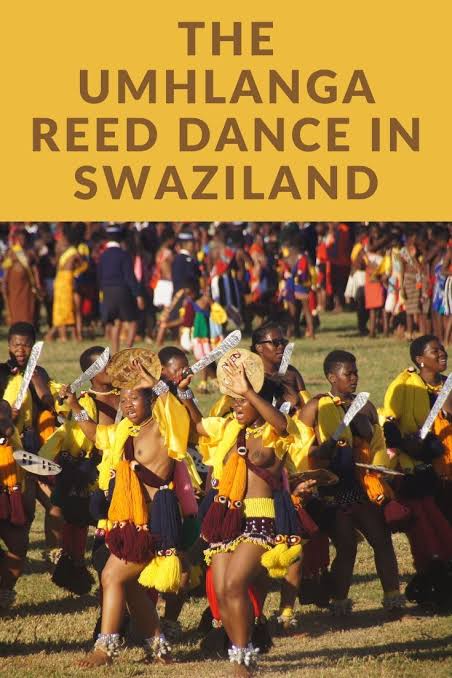The Umhlanga, or Reed Dance ceremony, is an annual Swazi event. The ceremony is an historic one, as it has been in existence since the days and times of King Sobhuza II in the 1940's.
(Sobhuza is Africa's oldest king, he ruled for 83 years. You can read a short bio about him on our IG/Twitter page @powerofafrica_)

The festival has a communal feel as it is observed by tens of thousands of unmarried and childless Swazi girls and women who travel from various chiefdoms to the Ludzidzini Royal Village to participate in the eight-day event. The young, unmarried girls were placed in female age-regiments and girls who had fallen pregnant outside wedlock had their families obliged to pay ransom with a cow. The reed dance festival is still in existence today in Eswatini (Swaziland) and South Africa. In South Africa, the reed dance was introduced in 1991 by Goodwill Zwelithini, the former King of the Zulus. The dance in South Africa takes place in Nongoma, a royal kraal of the Zulu king.
In South Africa, the ceremony is known as Umkhosi woMhlanga, and takes place every year in September at the Enyokeni Royal Palace in Nongoma Enyokeni, KwaZulu-Natal. The girls come from all parts of Zululand, and in recent years there are also smaller groups from Eswatini, as well as more distant places such as Botswana and Pondoland. The girls wear traditional attire, including beadwork, izigege, izinculuba and imintsha that show their bottoms. They also wear anklets, bracelets, necklaces, and colourful sashes. Each sash has appendages of a different colour, which denote whether or not the girl is betrothed.

As part of the ceremony, the young women dance bare-breasted for their king, and each maiden carries a long reed, which is then deposited as they approach the king. The girls take care to choose only the longest and strongest reeds, and then carry them towering above their heads in a slow procession up the hill to Enyokeni Palace. The procession is led by the chief Zulu princess, who takes a prominent role throughout the festival. If the reed should break before the girl reaches that point, it is considered a sign that the girl has already been sexually active.
In Eswatini, girls begin the rite by gathering at the Queen Mother's royal village, which currently is Ludzidzini Royal Village. After arriving at the Queen Mother's royal residence, the women disperse the following night to surrounding areas and cut tall reeds. The following night, they bundle the reeds together and bring them back to the Queen Mother to be used in repairing holes in the reed windscreen surrounding the royal village. After a day of rest and washing, the women prepare their traditional costumes consisting of a bead necklace, rattling anklets made from cocoons, a sash, and skirt. Many of them carry the bush knives, which they had earlier used to cut the reeds, as symbols of their virginity.

The women sing and dance as they parade in front of the royal family as well as a crowd of dignitaries, spectators, and tourists. After the parade, groups from select villages take to the centre of the field and put on a special performance for the crowd. The King's many daughters and royal princesses also participate in the reed dance ceremony and are distinguished by the crown of red feathers they wear in their hair.
The official purpose of the annual ceremony according to legend, is to preserve the women's chastity, provide tribute labour for the Queen Mother, and produce solidarity among the women through working together. The festival lasts for a week, with the last day which is known as the main day, observed nationally as a public holiday. It usually takes place around the last week of August or the first week of September.
Unlike other traditional cultural festivals in Africa, the Umhlanga Festival continues to grow in popularity and the people of Eswatini (Swaziland) have remained patriotic about their culture and this festival.
credits: Sam Adedoyin/ToluRock
